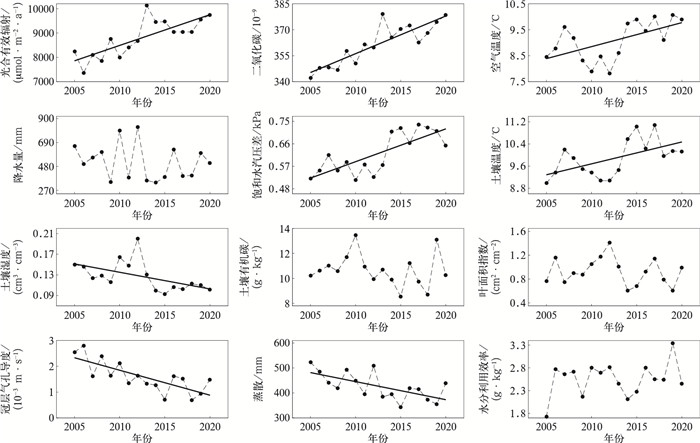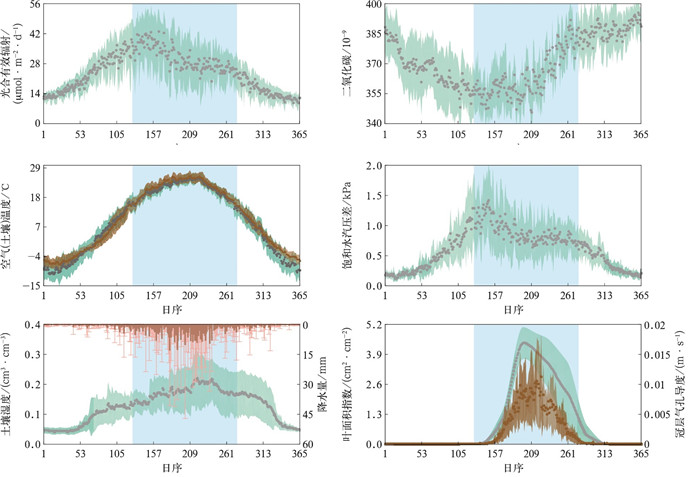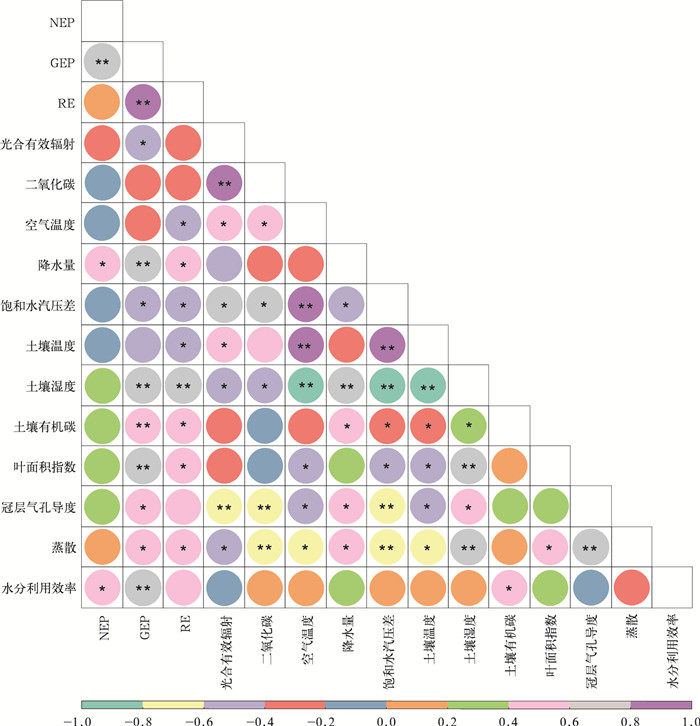Interannual Carbon Exchange Variability of Rain-fed Maize Fields in Northeast China and Its Influencing Factors
-
摘要: 在气候变化背景下,农田净生态系统生产力变化趋势和影响因素不确定性大,为有效评估农田生态系统的固碳潜力,利用2005—2020年东北雨养春玉米田涡动相关数据分析该区域碳通量年际变化趋势及其气象、土壤和生物影响因素。结果表明:东北雨养春玉米田净生态系统生产力为272±109 g·m-2·a-1,且无显著变化趋势;与生态系统呼吸相比,净生态系统生产力年际变化主要受总生态系统生产力影响。气象因素的降水量和生物因素的作物水分利用效率是净生态系统生产力年际变化的主要影响因素,影响权重分别为28.4%和31.4%;气象、土壤和生物因素对总生态系统生产力年际变化的影响权重分别为61.0%,43.8%和62.8%;土壤因素和生物因素是生态系统呼吸年际变化的主要影响因素,且土壤因素对生态系统呼吸年际变化的影响权重(39.3%)大于生物因素(29.2%)。在气候变暖背景下,东北雨养春玉米田对水分更为敏感,同时日照和温度通过影响饱和水汽压差和土壤湿度间接影响净生态系统生产力的年际变化。Abstract: Interannual variation in net ecosystem carbon production (NEP) plays an important role in the carbon cycle processes. An agricultural ecosystem may fluctuate between carbon net source and carbon sink, or it may remain neutral. Thus, the long-term trends in NEP and the relevant meteorological, soil and biotic control of interannual variation in NEP remain unclear in farmland agroecosystems. To effectively assess the carbon sequestration potential of the farmland ecosystem, the eddy covariance dataset of rain-fed spring maize in Northeast China from 2005 to 2020 are used to investigate the interannual variations in NEP and the relevant meteorological, soil and biotic influences. NEP is partitioned into gross ecosystem productivity (GEP) and ecosystem respiration (RE) to explain the interannual variations of NEP and its influencing factors. The average annual NEP, GEP and RE are 272±109, 1086±177, 820±130 g·m-2·a-1, respectively, with no significant changes. The day-to-day dynamics of NEP, GEP and RE show single peak curves. NEP and GEP reach the maximums at the very time of maize tasseling, and the maximum value of RE occurs 13 days after NEP and GEP. Compared with RE, NEP variations are mainly caused by GEP. The redundancy analysis shows the interannual variations in NEP are mainly affected by precipitation as the meteorological factor and water use efficiency as the biotic factor, and the influence weights of the meteorological and biotic factors are 28.4% and 31.4%. Meanwhile, the influence weights of the meteorological factors (photosynthetically active radiation, carbon dioxide and precipitation), soil (soil volumetric water content and soil organic carbon) and biotic factors (leaf area index and water use efficiency) are 61.0%, 43.8% and 62.8% for the interannual variations in GEP. The interannual variations in RE are mainly affected by the soil (soil volumetric water content and soil organic carbon) and the biotic factors (leaf area index), and the influence weight of the soil factors (39.3%) is larger than that of the biotic factor (29.2%). The results indicate that, under the background of climate warming, interannual variations in NEP in rain-fed spring maize agroecosystems are likely to be more sensitive to changes in moisture, while radiation and temperature will contribute to interannual NEP variations by affecting vapor pressure difference and soil water content.
-
图 2 2005—2020年NEP,GEP和RE多年平均逐日变化
(黑线表示10 d滑动平均,绿色阴影表示逐日标准差,蓝色阴影表示玉米生长季)
Fig. 2 Daily variations of net ecosystem production(NEP), gross ecosystem production(GEP) and ecosystem respiration(RE) from 2005 to 2020
(the black line denotes 10-day moving average, the green shaded denotes standard deviation, the blue shaded denotes growing season)
图 3 2005—2020年光合有效辐射、二氧化碳浓度、空气温度、降水量、饱和水汽压差、土壤温度、土壤湿度、土壤有机碳、叶面积指数、气孔导度、蒸散、水分利用效率的年际变化
(黑线表示显著变化趋势)
Fig. 3 Interannual variations of photosynthetically active radiation, carbon dioxide, air temperature, precipitation, vapor pressure difference, soil temperature, soil volumetric water content, soil organic carbon, leaf area index, canopy stomatal conductance, evapotranspiration and water use efficiency from 2005 to 2020
(the black line denotes significant trend)
图 4 2005—2020年光合有效辐射、二氧化碳浓度、空气温度(灰点)、土壤温度(褐点)、饱和水汽压差、土壤湿度(灰点)、降水量(红柱)、叶面积指数(灰点)和气孔导度(褐点)的逐日变化(绿色和褐色阴影表示逐日标准差,蓝色阴影表示平均生长季)
Fig. 4 Daily photosynthetically active radiation, carbon dioxide, air temperature(gray dots), soil temperature (brown dots), vapor pressure difference, soil volumetric water content(gray dots), precipitation(red bars), leaf area index(gray dots) and canopy stomatal conductance(brown dots) from 2005 to 2020 (the green and brown shaded denote standard deviations, the blue shaded denotes average growing season)
图 5 NEP,GEP和RE的关系
(黑实线表示显著相关,灰色阴影表示达到0.05显著性水平,灰虚线表示预测边界)
Fig. 5 Correlations among net ecosystem production(NEP), gross ecosystem productivity(GEP) and ecosystem respiration(RE)
(the black line denotes significant correlation, the grey shaded denotes 0.05 level, grey dashed lines denote prediction bounds)
表 1 基于冗余分析确定气象、土壤和生物因素对碳通量年际间变化的影响权重
Table 1 Weighing for interannual variability of carbon flux accounted by meteorological, soil and biotic factors using redundancy analysis
影响因素 NEP GEP RE 气象因素 28.4%* 61.0%** 土壤因素 43.8%* 39.3%* 生物因素 31.4%* 62.8%** 29.2%* 气象与土壤因素 7.2% 气象与生物因素 16.8% 16.8% 土壤与生物因素 7.4% 25.2% 气象、土壤与生物因素 27.7% 注: *表示达到0.05显著性水平,**表示达到0.01显著性水平。 -
[1] Dufranne D, Moureaux C, Vancutsem F, et al.Comparison of carbon fluxes, growth and productivity of a winter wheat crop in three contrasting growing seasons.Agric Ecosyst Environ, 2011, 141(1/2):133-142. [2] Wang Y, Zhou L, Jia Q, et al. Direct and indirect effects of environmental factors on daily CO2 exchange in a rainfed maize cropland-A SEM analysis with 10 year observations. Field Crop Res, 2019, 242: 107591. doi: 10.1016/j.fcr.2019.107591 [3] Baldocchi D, Chu H, Reichstein M. Inter-annual variability of net and gross ecosystem carbon fluxes: A review. Agric For Meteorol, 2018, 249: 520-533. doi: 10.1016/j.agrformet.2017.05.015 [4] Fu Z, Dong J W, Zhou Y K, et al. Long term trend and interannual variability of land carbon uptake the attribution and processes. Environ Res Lett, 2017, 12: 014018. doi: 10.1088/1748-9326/aa5685 [5] Jensen R, Herbst M, Friborg T. Direct and indirect controls of the interannual variability in atmospheric CO2 exchange of three contrasting ecosystems in Denmark. Agric For Meteorol, 2017, 233: 12-31. doi: 10.1016/j.agrformet.2016.10.023 [6] Shao J, Zhou X, Luo Y, et al. Biotic and climatic controls on interannual variability in carbon fluxes across terrestrial ecosystems. Agric For Meteorol, 2015, 205: 11-22. doi: 10.1016/j.agrformet.2015.02.007 [7] 张玉书. 东北粮食生产格局的气候变化响应与适应. 沈阳: 辽宁科学技术出版社, 2016.Zhang Y. Responses and Adapatation of Crop Production to Climate Change in Northeast China. Shenyang: Liaoning Science and Technology Publishing, 2016. [8] 李蕊, 郭建平. 东北春玉米非线性积温模型参数改进. 应用气象学报, 2018, 29(2): 154-164. doi: 10.11898/1001-7313.20180203Li R, Guo J P. Improving parameters of nonlinear accumulated temperature model for spring maize in Northeast China. J Appl Meteor Sci, 2018, 29(2): 154-164. doi: 10.11898/1001-7313.20180203 [9] Baldocchi D, Penuelas J. The physics and ecology of mining carbon dioxide from the atmosphere by ecosystems. Glob Change Biol, 2019, 25(4): 1191-1197. doi: 10.1111/gcb.14559 [10] Knox S H, Matthes J H, Sturtevant C, et al. Biophysical controls on interannual variability in ecosystem-scale CO2 and CH4 exchange in a California rice paddy. J Geophys Res Biogeo, 2016, 121(3): 978-1001. doi: 10.1002/2015JG003247 [11] Suyker A E, Verma S B. Gross primary production and ecosystem respiration of irrigated and rainfed maize-soybean cropping systems over 8 years. Agric For Meteorol, 2012, 165: 12-24. doi: 10.1016/j.agrformet.2012.05.021 [12] Baldocchi D D. How eddy covariance flux measurements have contributed to our understanding of global change biology. Glob Change Biol, 2019, 26(1): 242-260. [13] Froelich N, Croft H, Chen J M, et al. Trends of carbon fluxes and climate over a mixed temperate-boreal transition forest in southern Ontario, Canada. Agric For Meteorol, 2015, 211/212: 72-84. doi: 10.1016/j.agrformet.2015.05.009 [14] Pilegaard K, Ibrom A, Courtney M S, et al. Increasing net CO2 uptake by a Danish beech forest during the period from 1996 to 2009. Agric For Meteorol, 2011, 151(7): 934-946. doi: 10.1016/j.agrformet.2011.02.013 [15] Euskirchen E S, Bret-Harte M S, Shaver G R, et al. Long-term release of carbon dioxide from Arctic tundra ecosystems in Alaska. Ecosystems, 2017, 20(5): 960-974. doi: 10.1007/s10021-016-0085-9 [16] Bajgain R, Xiao X M, Basara J, et al. Carbon dioxide and water vapor fluxes in winter wheat and tallgrass prairie in central Oklahoma. Sci Total Environ, 2018, 644: 1511-1524. doi: 10.1016/j.scitotenv.2018.07.010 [17] Li G, Han H, Du Y, et al. Effects of warming and increased precipitation on net ecosystem productivity: A long-term manipulative experiment in a semiarid grassland. Agric For Meteorol, 2017, 232: 359-366. doi: 10.1016/j.agrformet.2016.09.004 [18] Wilkinson M, Eaton E L, Broadmeadow M S J, et al. Inter-annual variation of carbon uptake by a plantation oak woodland in south-eastern England. Biogeosciences, 2012, 9(12): 5373-5389. doi: 10.5194/bg-9-5373-2012 [19] Verduzco V S, Vivoni E R, Yépez E A, et al. Climate change impacts on net ecosystem productivity in a subtropical shrubland of northwestern México. Biogeosciences, 2018, 123(2): 688-711. doi: 10.1002/2017JG004361 [20] Zhang H, Zhao T, Lyu S, et al. Interannual variability in net ecosystem carbon production in a rain-fed maize ecosystem and its climatic and biotic controls during 2005-2018. Plos One, 2021, 16(5): e0237684. doi: 10.1371/journal.pone.0237684 [21] Chi J, Waldo S, Pressley S N, et al. Effects of climatic conditions and management practices on agricultural carbon and water budgets in the inland pacific northwest USA. J Geophys Res Biogeo, 2017, 122(12): 3142-3160. doi: 10.1002/2017JG004148 [22] Guo Q, Hu Z, Li S, et al. Contrasting responses of gross primary productivity to precipitation events in a water-limited and a temperature-limited grassland ecosystem. Agric For Meteorol, 2015, 214/215: 169-177. doi: 10.1016/j.agrformet.2015.08.251 [23] Quan Q, Tian D, Luo Y, et al. Water scaling of ecosystem carbon cycle feedback to climate warming. Sci Adv, 2019, 5(8). DOI: 10.1126/sciadv.aav1131. [24] Dold C, Büyükcangaz H, Rondinelli W, et al. Long-term carbon uptake of agro-ecosystems in the Midwest. Agric For Meteorol, 2017, 232: 128-140. doi: 10.1016/j.agrformet.2016.07.012 [25] Wagle P, Gowda P H, Northup B K, et al. Variability in carbon dioxide fluxes among six winter wheat paddocks managed under different tillage and grazing practices. Atmos Environ, 2018, 185: 100-108. doi: 10.1016/j.atmosenv.2018.05.003 [26] Guo H, Li S, Kang S, et al. Annual ecosystem respiration of maize was primarily driven by crop growth and soil water conditions. Agric Ecosyst Environ, 2019, 272: 254-265. doi: 10.1016/j.agee.2018.11.026 [27] Chen C, Li D, Gao Z Q, et al. Seasonal and interannual variations of carbon exchange over a rice-wheat rotation system on the north China plain. Adv Atmos Sci, 2015, 32: 1365-1380. doi: 10.1007/s00376-015-4253-1 [28] Zhou L, Wang Y, Jia Q, et al. Increasing temperature shortened the carbon uptake period and decreased the cumulative net ecosystem productivity in a maize cropland in Northeast China. Field Crop Res, 2021, 267: 108150. doi: 10.1016/j.fcr.2021.108150 [29] 陈雨烨, 王培娟, 张源达, 等. 基于3种遥感指数的东北春玉米干旱识别对比. 应用气象学报, 2022, 33(4): 466-476. doi: 10.11898/1001-7313.20220407Chen Y Y, Wang P J, Zhang Y D, et al. Comparison of drought recognition of spring maize in Northeast China based on 3 remote sensing indices. J Appl Meteor Sci, 2022, 33(4): 466-476. doi: 10.11898/1001-7313.20220407 [30] 蔡福, 米娜, 明惠青, 等. WOFOST模型蒸散过程改进对玉米干旱模拟影响. 应用气象学报, 2021, 32(1): 52-64. doi: 10.11898/1001-7313.20210105Cai F, Mi N, Ming H Q, et al. Effects of improving evapotranspiration parameterization scheme on WOFOST model performance in simulating maize drought stress prodess. J Appl Meteor Sci, 2021, 32(1): 52-64. doi: 10.11898/1001-7313.20210105 [31] 初征, 郭建平. 未来气候变化对东北玉米品种布局的影响. 应用气象学报, 2018, 29(2): 165-176. doi: 10.11898/1001-7313.20180204Chu Z, Guo J P. Effects of climatic change on maize varieties distribution in the future of Northeast China. J Appl Meteor Sci, 2018, 29(2): 165-176. doi: 10.11898/1001-7313.20180204 [32] 郭建平, 栾青, 王婧瑄, 等. 玉米冠层对降水的截留模型构建. 应用气象学报, 2020, 31(4): 397-404. doi: 10.11898/1001-7313.20200402Guo J P, Luan Q, Wang J X, et al. Model construction of rainfall interception by maize canopy. J Appl Meteor Sci, 2020, 31(4): 397-404. doi: 10.11898/1001-7313.20200402 [33] 朱梦媛, 张慧, 李爽, 等. 播种期水分胁迫及补水对玉米出苗率的影响. 气象与环境学报, 2019, 35(1): 101-107. https://www.cnki.com.cn/Article/CJFDTOTAL-LNQX201901014.htmZhu M Y, Zhang H, Li S, et al. Effects of water stress and supplement after sowing on emergence rates of maize. J Meteor Environ, 2019, 35(1): 101-107. https://www.cnki.com.cn/Article/CJFDTOTAL-LNQX201901014.htm [34] Zhang H, Wen X. Flux footprint climatology estimated by three analytical models over a subtropical coniferous plantation in Southeast China. J Meteorol Res Prc, 2015, 29: 654-666. [35] Hu Z, Yu G, Zhou Y, et al. Partitioning of evapotranspiration and its controls in four grassland ecosystems: Application of a two-source model. Agric For Meteorol, 2009, 149(9): 1410-1420. [36] Ball J T, Woodrow I E, Berry J A. A Model Predicting Stomatal Conductance and Its Contribution to the Control of Photosynthesis Under Different Environmental Conditions. Dordrecht: Springer, 1987. [37] 于贵瑞, 王秋凤. 植物光合、蒸腾与水分利用的生理生态学. 北京: 科学出版社, 2010.Yu G R, Wang Q F. Ecophysiology of Plant Photosynthesis, Transpitation, and Water Use. Beijing: Science Press, 2010. [38] 于贵瑞, 孙晓敏. 陆地生态系统通量观测的原理与方法(第二版). 北京: 高等教育出版社, 2017.Yu G R, Sun X M. Principles of Flux Measurement in Terrestrial Ecosystems(Second Edition). Beijing: Higher Education Press, 2017. [39] Burba G. Eddy Covariance Method for Scientific, Regulatory, and Commercial Applications. Lincoln: LI-COR Biosciences, 2022. [40] Reichstein M, Falge E, Baldocchi D, et al. On the separation of net ecosystem exchange into assimilation and ecosystem respiration: Review and improved algorithm. Glob Change Biol, 2005, 11(9): 1424-1439. [41] Lloyd J, Taylor J. On the temperature dependence of soil respiration. Funct Ecol, 1994, 8: 315-323. [42] Magney T S, Bowling D R, Logan B A, et al. Mechanistic evidence for tracking the seasonality of photosynthesis with solar-induced fluorescence. PNAS, 2019, 116(24): 11640. [43] 刘维, 宋迎波. 基于气象要素的逐日玉米产量气象影响指数. 应用气象学报, 2022, 33(3): 364-374. doi: 10.11898/1001-7313.20220310Liu W, Song Y B. A daily meteorological impact index of maize yield based on weather elements. J Appl Meteor Sci, 2022, 33(3): 364-374. doi: 10.11898/1001-7313.20220310 [44] 冯晓钰, 周广胜. 碳四植物光合生化机理模型的叶片含水量修正. 应用气象学报, 2022, 33(3): 375-384. doi: 10.11898/1001-7313.20220311Feng X Y, Zhou G S. Modification of leaf water content for the photosynthetic and biochemical mechanism model of C4 plant. J Appl Meteor Sci, 2022, 33(3): 375-384. doi: 10.11898/1001-7313.20220311 [45] Niu S, Fu Z, Luo Y, et al. Interannual variability of ecosystem carbon exchange: From observation to prediction. Global Ecol Biogeogr, 2017, 26(11): 1225-1237. [46] 霍治国, 张海燕, 李春晖, 等. 中国玉米高温热害研究进展. 应用气象学报, 2023, 34(1): 1-14. doi: 10.11898/1001-7313.20230101Huo Z G, Zhang H Y, Li C H, et al. Review on high temperature heat damage of maize in China. J Appl Meteor Sci, 2023, 34(1): 1-14. doi: 10.11898/1001-7313.20230101 [47] 宋艳玲. 全球干旱指数研究进展. 应用气象学报, 2022, 33(5): 513-526. doi: 10.11898/1001-7313.20220501Song Y L. Global research progress of drought indices. J Appl Meteor Sci, 2022, 33(5): 513-526. doi: 10.11898/1001-7313.20220501 [48] 米前川, 高西宁, 李玥, 等. 深度学习方法在干旱预测中的应用. 应用气象学报, 2022, 33(1): 104-114. doi: 10.11898/1001-7313.20220109Mi Q C, Gao X N, Li Y, et al. Application of deep learning method to drought prediction. J Appl Meteor Sci, 2022, 33(1): 104-114. doi: 10.11898/1001-7313.20220109 [49] Goulden M L, Bales R C. California forest die-off linked to multi-year deep soil drying in 2012-2015 drought. Nat Geosci, 2019, 12: 632-637. [50] Yuan W, Zheng Y, Piao S, et al. Increased atmospheric vapor pressure deficit reduces global vegetation growth. Sci Adv, 2019, 5(8). DOI: 10.1126/sciadv.aax1396. -


 设为首页
设为首页 加入收藏
加入收藏



 下载:
下载:






